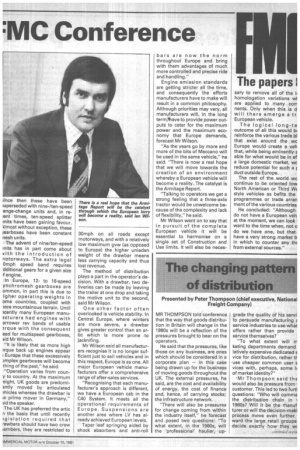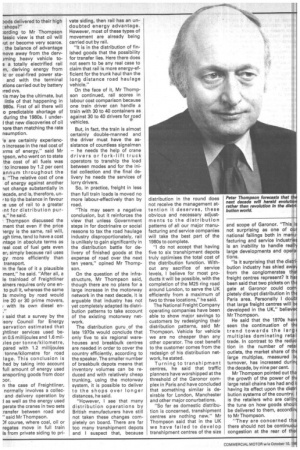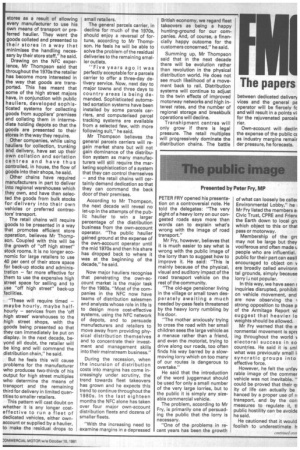The changing P .t a e
Page 21

Page 22

Page 23

If you've noticed an error in this article please click here to report it so we can fix it.
of distribution
Presented by Peter Thompson (chief executive, National Freight Company)
MR THOMPSON told conference that the way that goods distribution in Britain will change in the 1980s will be a reflection of the pressures brought to bear on the operators.
He said that the pressures, like those on any business, are ones which should be considered in a corporate plan — in this case being drawn up for the business of moving goods throughout the UK. The external pressures, he said, are the cost and availability of energy, the cost of finance and, hence, of carrying stocks; the infrastructure network.
"There will also be pressures for change coming from within the industry itself," he forecast and posed two questions: "To what extent, in the 1980s, will the 'professional' haulier, up
grade the quality of his servi to persuade manufacturing E service industries to use what offers rather than provide service themselves?
"To what extent will rr keting departments demand latively expensive dedicated s vice for distribution, rather ti. use cheaper common user s vices with, perhaps, some I( of market identity?"
'Mr Thompson said thE would also be pressure from 1 customer. This led to two furtl questions: "Who will comma the distribution chain in 1980s? Will it be the manuf turer or will the decision-maki process move even further ward the large retail groups decide exactly how they wt Dods delivered to their high :shops?"
:ording to Mr Thompson lassic view is that oil will lut or become very scarce. . the balance of advantage nove away from the dervming heavy vehicle tos a totally electrified rail m, deriving energy from ic or coal-fired power staand with the terminal )tions carried out by battery red cvs.
us may be the ultimate, but little of that happening in 980s. First of all there will o predictable shortage of during the 1980s. I underthat new discoveries of oil lore than matching the rate nsumption.
'e are certainly experiencn increase in the real cost of arms of energy," said Mr pson, who went on to state the cost of all fuels was • to increase by 1.2 per cent annum throughout the s. "The relative cost of one of energy against another lot change substantially in lecade, and is, therefore, unto tip the balance in favour le use of rail to a greater nt for distribution purs," he said, • Thompson discussed the ment that even if the price lergy is the same, rail will, igh time, tend to have a cost intage in absolute terms as real cost of fuel gets even er, simply because rail uses gy more efficiently than transport.
In the face of it a plausible ment," he said. "After all, a le trainload of Freightliner ainers requires only one ento pull it, whereas the same is moving by road would ire 20 or 30 prime movers, with its own diesel en said that a survey by the sory Council for Energy servation estimated that jhtliner services used be m 0.5 millijoules and 1.6 milJles per tonne/kilometre, pared with 1.2 millijoules tonne/kilometre for road lege. This conclusion is hed by taking into account full amount of energy used ansporting goods from door Dor.
n the case of Freightliner, normally involves a collecand delivery operation by i as well as the energy used perate the cranes in two sets ransfer between road and "said Mr Thompson, If course, where coal, oil or regates move in full train Is from private siding to pri vate siding, then rail has an undoubted energy advantage. However, most of these types of movement are already being carried out by rail.
"It is in the distribution of finished goods that the possibility for transfer lies. Here there does not seem to be any real case to claim that rail is more energy-efficient for the trunk haul than the long distance road haulage vehicle."
On the face of it, Mr Thompson continued, rail scores in labour cost comparison because one train driver can handle a train with 30 to 40 containers as against 30 to 40 drivers for road vehicles.
But, in fact, the train is almost certainly double-manned and the driver must have the assistance of countless signalmen — he needs the help of crane drivers or fork-lift truck operators to tranship the load between modes and for the initial collection and the final delivery he needs the services of lorry drivers.
So, in practice, freight in less than full train loads is moved no more labour-effectively than by road.
"This may seem a negative conclusion, but it reinforces the view that unless Government steps in for doctrinaire or social reasons to tax the road haulage industry disproportionately, rail is unlikely to gain significantly in the distribution battle for delivery of finished goods at the expense of road over the next ten years," opined Mr Thompson.
On the question of the infrastructure, Mr Thompson said, though there are no plans for a large increase in the motorway network in the next decade, it is arguable that industry has not yet completely adapted its distribution patterns to take account of the existing motorway network.
The distribution guru of the late 1970s would conclude that only five to six regional warehouses and breakbulk centres are needed in order to cover the country efficiently, according to the speaker. The smaller number of breakbulk depots means that inventory volumes can be reduced and with relatively cheap trunking, using the motorway system, it is possible to deliver to the shops over longer distances, he said.
"However, I see that many distribution operations by British manufacturers have still not taken these changes completely on board. There are far too many transhipment depots and I suspect that, because distribution in the round does not receive the management attention it deserves, these obvious and necessary adjustments to the distribution patterns of all our major manufacturing and service companies will take the best part of the 1980s to complete.
"I do not accept that having five to six transhipment depots truly optimises the total cost of the distribution function. Without any sacrifice of service levels, I believe for most products it will be possible, with the completion of the M25 ring road around London, to serve the UK efficiently from a maximum of two to three locations," he said.
The National Freight Company operating companies have been able to show major savings to customers by redesigning their distribution patterns, said Mr Thompson. Vehicle for vehicle we are no cheaper than any other operator. The cost benefit to the customer comes from the redesign of his distribution network, he stated.
Turning to transhipment centres, he said that traffic planners have worshipped at the threshold of the Garonor complex in Paris and have concluded that something similar is desirable for London, Manchester and other major conurbations.
"So far as domestic distribution is concerned, transhipment centres are nothing new." Mr Thompson said that in the UK we have failed to develop transhipment centres of the size
and scope of Garonor. "This is not surprising as one of our national failings both in manufacturing and service industries is an inability to handle really large developments and operations.
"Is it surprising that the distribution industry has shied away from the conglomerates thai freight centres represent? It hae been said that two pickets on the gate at Garonor could completely disrupt distribution in the Paris area. Personally I doubl that large freight centres will be developed in the UK," believet Mr Thompson.
He said that the 1970s have seen the continuation of thE trend towards the large multiples dominating retal trade. In contrast to the reduc tion in the number of retai outlets, the market share of the large multiples, measured ID) turnover, has increased durinc the decade, by nine per cent.
Mr Thompson pointed out tha the growth of the power of th( large retail chains has had and having its effect upon the distri bution systems of the country. I is the retailers who are callinc the tune on how goods shoulc be delivered to them, accordinc to Mr Thompson.
"They are concerned tha there should not be continuoug congestion at the rear of thei stores as a result of allowing every manufacturer to use his own means of transport or preferred haulier. They want the goods collated and presented to their stores in a way that minimises the handling necessary by their store staff," he said.
Drawing on the NFC experience, Mr Thompson said that throughout the 1970s the retailer has become more interested in the way that goods are transported. This has meant that some of the high street majors have, in conjunction with public hauliers, developed sophisticated systems for collecting goods from suppliers' premises and collating them in intermediate holding depots so that the goods are presented to their stores in the way they require.
Other companies, while using hauliers for collection, trunking and delivery, have set up their own collation and sortation centres and have thus controlled, in house, the flow of goods into their shops, he said.
Other chains have required manufacturers in part to deliver into regional warehouses which they own, and have then selected the goods from bulk stocks for delivery into their own vehicles or preferred contractors' transport.
The retail chains will require goods to be presented in a way that promotes efficient store operation, believes Mr Thompson. Coupled with this will be the growth of "off high street" stock rooms. It is no longer economic for large retailers to use 40 per cent of their store space for back-up stocks and administration — far more effective for them to use the expensive high street space for selling and to use "off high street" back-up facilities.
"These will require timed — maybe hourly, maybe halfhourly — services from the 'off high street' warehouses to the high street shops, with the goods being presented so that they can immediately be put on display. In the next decade, beyond all doubt, the retailer will be king and will command the distribution chain," he said.
But he feels this will cause problems for the manufacturer who produces two-thirds of his output for high street multiples who determine the means of transport and the remaining third for delivery in limited quantities to smaller retailers.
This pattern will cast doubt on whether it is any longer costeffective to run a fleet of dedicated vehicles, either ownaccount or supplied by a haulier, to make the residual drops to small retailers.
The general parcels carrier, in decline for much of the 1970s, should enjoy a reversal of fortune, according to Mr Thompson. He feels he will be able to solve the problem of the residual deliveries to the remaining smaller outlets.
"Five years ago it was perfectly acceptable for a parcels carrier to offer a three-day delivery service. Now, next day to major towns and three days to country areas is being demanded. Sophisticated automated sortation systems have been installed by some parcels carriers, and computerised parcel tracking systems are available from a selected few, with more following suit," he said.
Mr Thompson believes the general parcels carriers will regain market share but will not gain dominance of the distribution system as many manufacturers will still require the marketing sophistication of a system that they can control themselves — and the retail chains will certainly demand dedication so that they can command the back door of their premises.
According to Mr Thompson, the next decade will reveal no let-up in the attempts of the public haulier to win a larger percentage of the distribution business from the own-account operator. "The public haulier gained ground at the expense of the own-account operator until the mid 1970s and then his share has dropped back to where it was at the beginning of the decade," he said.
Now major hauliers recognise that penetrating the own-account market is the major task for the 1980s. "Most of the companies in the NFC now have teams of distribution salesmen and analysts whose role in life is to design more cost-effective systems, using the NFC network of depots, and to persuade manufacturers and retailers to move away from providing physical distribution themselves and to concentrate their investment and management skills into their mainstream business."
During the recession, when the incursion of distribution costs into margins has come increasingly under scrutiny, the trend towards fleet takeovers has grown and he expects this trend to continue throughout the 1980s, In the last eighteen months the NFC alone has taken over four major own-account distribution fleets and dozens of smaller fleets.
"With the increasing need to examine margins in a depressed British economy, we regard fleet takeovers as being a happy hunting-ground for our companies. And, of course, a financially happy outcome for the customers concerned," he said.
Summing up, Mr Thompson said that in the next decade there will be evolution rather than revolution in the physical distribution world. He does not see much likelihood of a movement back to rail. Distribution systems will continue to adjust to the twin effects of improved motorway networks and high interest rates, and the number of regional storage and breakbulk operations will decline.
Transhipment centres will only grow if there is legal pressure. The retail multiples will progressively dominate the distribution chains. The battle between dedicated delivery vices and the general pa operator will be fiercely fc and will result in a points vi. for the rejuvenated parcels rier.
Own-account will declin the expense of the public CC as industry margins remair der pressure, he forecasts.
























































